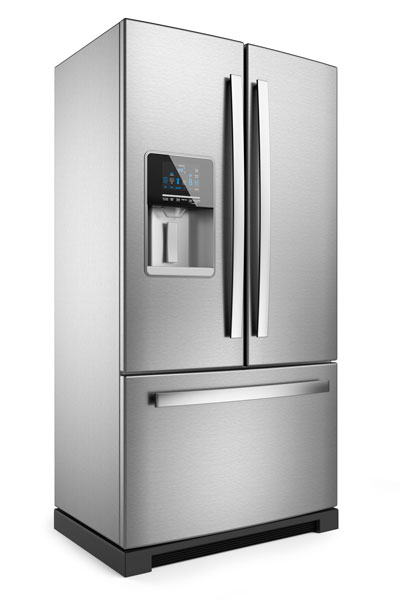How to Connect a Reverse Osmosis System to a Refrigerator or Ice Maker
How to Install a Line from Reverse Osmosis Water Filter to Refrigerator
If you have a refrigerator with a water dispenser and/or ice maker, you may want to run the water line from your reverse osmosis system drinking water system (installed under your kitchen sink) to the fridge. This way you'll have RO-treated water at your fridge dispenser and eliminate the need to purchase expensive refrigerator filters.
You can hire a water treatment specialist to do the installation for you, or you can follow these step-by-step instructions below and set it up yourself.
 First, keep in mind that water pressure from the RO system will be about 2/3 the pressure of the cold-water line. And there may be specific pressure considerations for some refrigerators requiring you to consult a local water treatment expert.
First, keep in mind that water pressure from the RO system will be about 2/3 the pressure of the cold-water line. And there may be specific pressure considerations for some refrigerators requiring you to consult a local water treatment expert.
Secondly, before you begin the project, you'll need to acquire an RO Fridge Ice maker Kit based on the size of your tubing. Generally, the tubing is 3/8" or 1/4".
Step-by-Step Instructions for Connecting a Fridge/Ice maker to Reverse Osmosis
What are the necessary steps to connect an RO system to the ice maker?
1. Prepare for connection
Shut off the cold water line coming into your RO system and locate the tube that connects your RO system to your RO water faucet. Place a large bowl or bucket near the RO system below this tube.
2. Cut the tubing
Cut the tubing approximately 10 inches from where the tube comes out of the RO system, letting water drain into the bowl or bucket
3. Install tee fittings
Install the tee fitting on the tubing connected to the RO system by pushing one of the two aligning ends onto the tubing as far as you can, then pulling lightly to verify tubing is secure.
Install the other end of the aligning Tee fitting into the remaining cut tube connected to the faucet.
If your refrigerator has copper piping for the icemaker line, do not connect your reverse osmosis drinking water system to the fridge. Copper piping or fittings should not be used with RO-treated water.
4. Insert perpendicular tee line
Take the new ¼” tubing and cut a 10” piece off. Insert the 10” piece of tubing into the Tee line, which should be perpendicular to the tubing line going from the RO system to the faucet.
5. Connect inline shut-off ball valve
Connect the inline shut-off ball valve into the other end of the 10” tubing.
Connect one end of the remaining long ¼” tubing to the other end of the shutoff ball valve. This valve should be turned off (pointed perpendicular from the tubing line) until the holding tank is completely filled.
6. Connect tubing from RO to fridge
Run the ¼” polypropylene tubing from the reverse osmosis system and connect to the refrigerator. Generally, 20 feet of tubing is enough, but you can run up to 30 feet. If you use more than 30 feet of tubing between the RO system and fridge, use a tube larger than ¼” tubing and fittings for best results.
Connect the tubing to the refrigerator/ice maker using a ¼” x ¼” union if necessary.
Water Pressure Tip
Be sure you have the recommended water pressure to your ice maker. This will be defined by the refrigerator manufacturer in your fridge owner's manual.
When it is time to change your RO filters, shut off the inline valve until the filter change is complete and the system has been thoroughly flushed.
Kits for Connecting Your Reverse Osmosis System to Your Refrigerator
Connection kit includes:
-
PI301208S Reducing Union Tee
-
PP0408W Union Connector
-
PPSV040808W Inline Ball Valve
-
Tubingblue-14 Blue Tubing - 20 fta
Connection kit includes:
- PP0208W Union Tee 1/4” x 1/4” x 1/4"
- PP0408W Union Connector 1/4" x 1/4"
- PPSV040808W Inline Ball Valve 1/4" x 1/4"
- Tubingblue-14 Blue Tubing 1/4" – 20 ft
This set-up is not recommended for applications requiring more than 30 feet of tubing without modifications including tubing larger than ¼” and connectors.
Expert Tip
Most reverse osmosis drinking water systems utilize John Guest fittings, which are popular quick-connect fittings that make installation easy without the need for tools. Also, their push-fit design ensures secure tubing connections, minimizing the risk of leaks. Learn how to connect and disconnect your RO system tubing with John Guest fittings.





